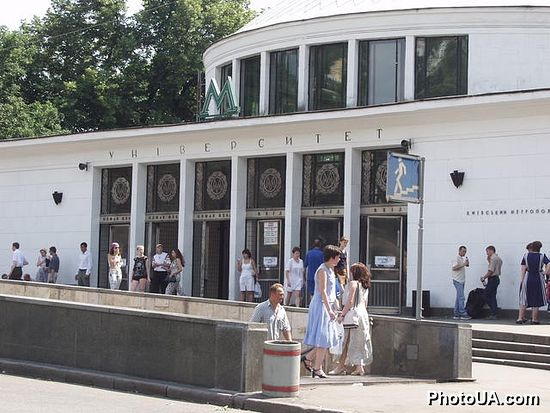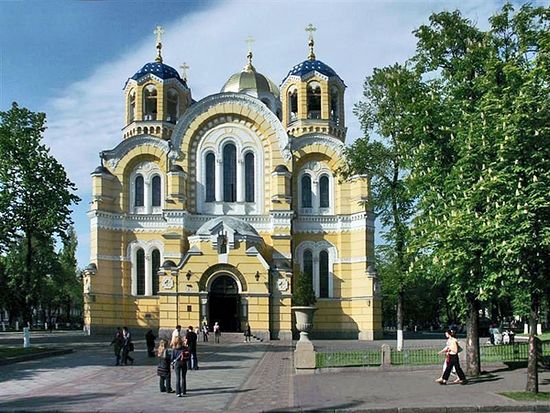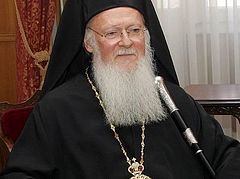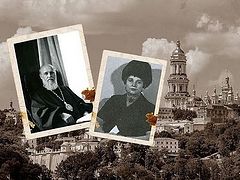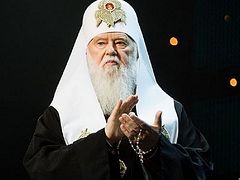This article, written in 2015 by Ukrainian journalist Vasily Anisimov (now head of the official website of the Ukrainian Orthodox Church), goes into grueling detail on the fate of his ill-starred hierarchs who wanted to respond to the voice of their conscience and expose Philaret Denisenko’s schism’s mafia-like inner workings. Tragically, these men were not able to realize their intentions of being rejoined to the canonical Ukrainian Orthodox Church.
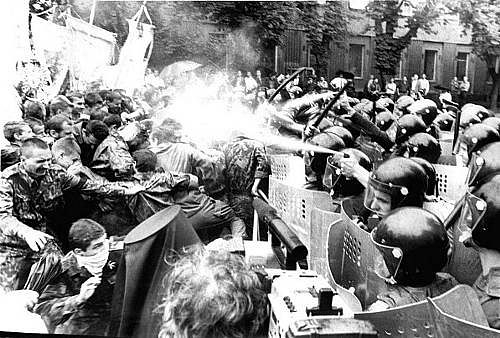 “Black Tuesday”—the funeral of "Patriarch" Vladimir Romaniuk. Photo: livejournal.com
“Black Tuesday”—the funeral of "Patriarch" Vladimir Romaniuk. Photo: livejournal.com
July 18, [2015] was the twentieth anniversary of “Black Tuesday,” or the second “Sophia Massacre,” organized by UNA-UNSO1 militants, the Special Services, and Philaretian schismatics. It was an attempted coup to remove the president from power. As you know, the attempt was unsuccessful—Leonid Kuchma harshly suppressed the provocation. Riot police beat and teargassed not only the insurgents, but also the deputies and ambassadors of Western powers covering them. Streaming tears, the various sides, including Leonid Kravchuk, diplomats, and Philaretians fled from the Sophia Maidan [square], and at least two of them were killed in the stampede—a cross was erected in their memory. The Ukrainian Prime Minister and law enforcement officers were sent into retirement.
The occasion for the anti-government provocation was the mysterious death of the “Patriarch” of the schismatic UOC-KP2 Vladimir (Vasily Emelyanovich) Romaniuk. This priest of the Orthodox Church and inmate of the Soviet camps departed for the autocephalous schism, then ended up as the figurehead for M. Denisenko (Philaret), who was his deputy, but in fact had (and maintains) a death grip on the entire schismatic pseudo Church. Romaniuk feared and hated his host, rightfully believing that he, as his predecessor Mstislav Skripnik (the nephew of Symon Petliura),3 was being used as a screen to cover mafia scams. Philaret, in turn, saw nothing remarkable in Romaniuk (“a village priest!”), except his heroic-patriotic biography—having twice served the sentence of a dissident. Therefore, the “patriarchate” of the dissident lasted less than two years—he rebelled, issuing a decree on the dismissal of Philaret from all positions and entered into unification negotiations with the leadership of the Ukrainian Orthodox Church; he also appealed to the Kiev Administration for Fighting Organized Crime4 of the Ukrainian Ministry of Internal Affairs5 with a request to protect him from Philaret, fearing he would be poisoned or physically disposed of. He also asked for help in the search and return of three billion rubles from UOC6 Church funds, which, according to Romaniuk’s investigation, Philaret had “commandeered” back in 1990 and converted and deposited in German banks.
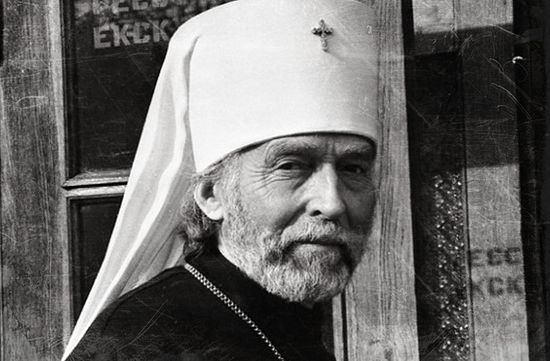 "Patriarch" Vladimir Romaniuk. Photo: static.life.ru
"Patriarch" Vladimir Romaniuk. Photo: static.life.ru
Romaniuk’s revolt ended on July 14, 1995 with his mysterious death on a bench in the botanical garden, the massacre at his “funeral” on July 18, and the opening of criminal cases. The Prosecutor’s office stated that Romaniuk’s death was being investigated as part of the large criminal case on “the events of July 18” (the organization of mass riots, the coup attempt) and all the guilty would be identified, found, and punished. President Leonid Kuchma also made a threatening announcement about it. Indeed, they started searches and interrogations, and Philaret even publicly complained that they were dealing with him “as with criminals.” Law enforcement was firmly engaged with the Philaret mafia octopus: under a pseudo-religious cover they found a commercial bank and business structures involved in whatever was profitable—importing foreign cars, selling household appliances, gas, etc. for millions of dollars with “criminal concealment of income from taxation.” It seemed that Philaret’s racket was laughing all the way to the bank.
However, the months passed, a year passed, a second, and the criminal case was investigated and investigated. Finally, Leonid Kuchma (president at that time!) began to publicly threaten some unknown opponents that he would “someday tell the whole truth about ‘Black Tuesday!’” What? It turns out that crimes and even murders don't have to be reported to the public by prosecutors in court, but by the president in his own recollections, which, by the way, he hasn’t found the courage to share yet. As they say—Ukraine is not Russia.
It is obvious that Kuchma, and later his pupil Yanukovich, was afraid of sanctions and obstruction from the West for the “brutal beatings” by the riot police at St. Sophia’s, and therefore he went in for a political compromise: The West and the Philaretians completely forgot about the St. Sophia massacre and the murdered protesters, and the authorities forgot about the coup and about Romaniuk. The criminal case was “suspended,” and it remains so until today, although already two dozen Ukrainian General Prosecutors have come and gone.
I feel sorry for Vladimir Romaniuk. He was an ardent reader of my investigative works, although I didn’t have a single good word to write about the schisms he remained in. It was an interesting time: A journalist exposed the mafia structure under the name of the UOC-KP, and Romaniuk, its “patriarch”—its head, strongly supported and encouraged him that journalist to do so! Vasily [Vladimir] Emelyanovich [Romaniuk], of course, was a man of a tragic, often broken fate—his whole life was spent now in prison, now under supervision, and always under threat of violence. He lied on order, made preposterous militant schismatic statements, but was a brave dissident: Knowing he was always under the surveillance of Philaret and the Ukrainian Security Service, he still found the opportunity to protest and tell about how far from everything in the schism was smooth and sweet, about how the Kravchuk-Philaretians and the whole pack of state, Uniate, and schismatic media outlets were lying. And so, he fought for the truth under labor camp-like conditions.
The recently excommunicated M. Denisenko (Philaret), together with those recently anathematized, shed the necessary crocodile tears at Vladimir Romaniuk’s grave at the walls of St. Sophia’s (by the way, the reposed had asked to be buried in Vydubychi cemetery7). Again, not a word about the need for an investigation into the murder, for searches, and the bringing to justice of the mysterious “killer-resuscitators” was to be heard. It’s obviously not interesting to Mikhail [Philaret] Antonivich—he knows by whom and why the dissident was killed. Of course, there is no new information in the investigation, and where would it come from if no one brings it forth? However, even the old theories, possible motives for the crime, arrived at while the trail was still hot, are not being investigated. Therefore, on the anniversary of “Black Tuesday,” I think it would be useful to remind you of it once again. Therefore, let’s take a look at the old publications.
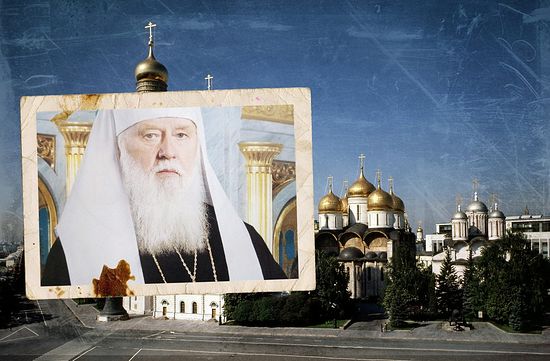 "Patriarch" Philaret Denisenko. Photo: life.ru
"Patriarch" Philaret Denisenko. Photo: life.ru
Do people die for gold?8
The Kiev AFOC’s theory on the main reason for “Black Tuesday,” appearing in Major I. Zagrebelny’s report to General N. Poddubny, can be boiled down to: “Patriarch Vladimir (Romaniuk) was planning to carry out in the near future a comprehensive inspection of the financial-economic activity of the Kiev Diocese headed by Philaret.”
This report sheds light on the relationship between Romaniuk and his deputy [Philaret] and the entire Philaret deputy-state mafia, and therefore it is here reproduced in full:
***
“In February 1994, the head accountant for the UOC-KP Archpriest Alexander Kislashko (the rector of a parish in Vishnev) appealed to the Kiev AFOC with a request to investigate the financial activities of the UOC-KP.
“A study of the affair showed that the church structures were involved in criminal activities. Therefore, starting from February 1994, the Kiev AFOC closely cooperated with the UOC-KP’s “Mission for the Revival of Christianity”, with the agreement of Patriarch Vladimir (Romaniuk). The purpose of this cooperation was to shield the church from the intrusion of the criminogenic element.
“In March 1995, a meeting of the Synod of the UOC-KP was held, at which Patriarch Vladimir faced forceful pressure from those around [Metropolitan] Philaret and the Parliamentary Deputies who supported him, including Porovsky, Chervony, and Mulyava. Patriarch Vladimir (Romaniuk’s) residence at 36 Pushkin Street was picketed by members of the UNA-UNSO from Rivne Province.9 As a result, Bishop Roman of Rivne was removed from office, against the view of the patriarch.
“After the described events, Patriarch Vladimir (Romaniuk) turned to the head of the Kiev MIA with an appeal to ensure his safety. On April 11, 14, and 20, 1995, I, the head of the 2nd Division of the Kiev AFOC and police Major I. T. Zagrebelny, had meetings with Patriarch Vladimir (Romaniuk). In the conversations that took place, the latter informed me that from the moment of his election as patriarch of the UOC-KP, he has been constantly subjected to negative pressure from Bishop Philaret’s entourage. Vladimir (Romaniuk) was particularly concerned about Philaret’s extensive ties with government agencies and the criminal world—in particular, with large organized criminal groups of the capital. Patriarch Vladimir (Romaniuk) noted that Philaret may have tried to poison him, arguing that his health improved when he got a separate kitchen from Philaret.
“On May 19, 1995, Patriarch Vladimir (Romaniuk) met with the head of the Kiev MIA General-Lieutenant of Police N. O. Poddubny. During the conversation, Vladimir appealed with a request for law enforcement protection during the next day’s UOC-KP Synod meeting, which was to decide the question of the removing the positions occupied by Philaret that were against the Church canons. Patriarch Vladimir (Romaniuk) asked the leadership of the Kiev MIA to warn Philaret not to engage in any provocations, which could cause mass riots.
“In connection with the above-outlined, in the period from May 19 to 21, 1995, Patriarch Vladimir (Romaniuk) was under round-the-clock physical protection by employees of the Kiev AFOC. During this time, Vladimir (Romaniuk’s) opponents made several attempts at provocations:
-
“The patriarch’s residence was blocked by parishioners of St. Vladimir Cathedral, under Philaret’s jurisdiction, due to which he could not leave his room and was subjected to insults and threats of physical violence;
-
“Clergymen—supporters of Philaret—attempted to break into the patriarch’s room to force him to abandon his intentions regarding Philaret (to remove him from his position—Ed.); during the conversation with Vladimir, the Church dignitaries went so far as to shout insults, behaving rudely;
-
“During the night of May 19–20, 1995, the Chancellor of the Kiev Diocese, Fr. Boris, sent a squad of police of the Old Kiev Regional Chief Ukrainian National Police to Patriarch Vladimir (Romaniuk’s) room;
-
“On May 20, 1995, parishioners of the St. Vladimir Cathedral blocked the entrance to the territory of the St. Theodosius Monastery at 32 January Uprising Street, to keep the patriarch from the place where the UOC-KP Synod was being held; these individuals were holding pre-made placards in their hands, with insulting inscriptions against Patriarch Vladimir (Romaniuk)—“Vladimir, get out of Ukraine,” “We want to see Patriarch Philaret,” and others; they shouted threats and insults;
-
“Patriarch Vladimir (Romaniuk) categorically insisted that the closed Synod session be guarded from the intrusion of unauthorized persons; all the priests and civilians were warned about it, having arrived at the place of the Synod meeting; however, the Deputies Mulyava and Chervony, incited by Church officials from Philaret’s inner circle, made a blatant attempt to break into the hall where the Synod was meeting; to this end Deputy Chervony summoned the police from the Pechersky Regional National Police of Kiev.
“After the described events, Patriarch Vladimir (Romaniuk) met with the leadership of the Kiev MIA N. O. Poddubny and G. N. Lyaskovsky. He expressed his personal gratitude for their help and support and gave them personalized gramotas with a patriarchal blessing. During the conversation, Vladimir stated that the UOC-KP supports the administration of President L. D. Kuchma of Ukraine in carrying out reforms and condemns the actions of Metropolitan Vladimir (Sabodan), subordinate to the Moscow Patriarchate, who calls all parishioners to sabotage these reforms in favor of Russia. Patriarch Vladimir expressed his desire to continue to support cooperation with state authorities for the good of Ukraine.
“It should be noted that Patriarch Vladimir (Romaniuk) was planning in the near future to carry out a comprehensive audit of the financial-economic activities of the Kiev Diocese, led by Philaret. He asked the leadership of the Kiev MIA to help carry out the audit. Vladimir (Romaniuk) was especially interested in the fate of the Kiev Exarchate treasury, misappropriated by Philaret, that had about three billion rubles in 1990. In Vladimir (Romaniuk’s) opinion, this money was transferred to a freely convertible currency and invested in deposit accounts in banks outside Ukraine. Vladimir (Romaniuk’s) request was motivated by the fact that he could not carry it out himself without the support of the state, due to opposition from Philaret and his entourage. However, the UOC-KP is in dire need of funds for the restoration of destroyed churches, the building of new churches, and to provide assistance to children and the elderly.
“Head of the 2nd Department of the Kiev AFOC Police Major I. T. Zagrebelny
July 25, 1995”
***
Note that it was the same group of people who both organized the harassment of Romaniuk, chasing him as an enemy out of Ukraine, and organized his patriotic burial. The authorities gave permission to bury him at Baikove (the main cemetery of Ukraine), but provocateurs turned the thousands-strong funeral procession in the opposite direction, to St. Sophia’s, breaking through the police cordons with the casket, and they buried Romaniuk on the side of the square at the entrance to the bell tower, for which they were brutally beaten and dispersed. tas even more brutal than the “Onizhedeti” protest of that October night in 2013.10
Death on a park bench
The circumstances of Vladimir Romaniuk’s death are recorded as “unknown” in the forensic medical examination certificate No. 3479 of July 15, 1995 of the Kiev Province Bureau of Forensic Medical Examinations, signed by medical examiner V. T. Yurchenko. A dead, bloodied man is picked up on the street, taken to the morgue, and there are no proceedings, no witnesses? Is that even possible? It’s possible since no one called any police to the scene of the crime, and they didn’t take him to the morgue.
The circumstances were revealed only on July 19 (a day after the burial-massacre and five days after his death) in the resolution on the appointment of a forensic examiner by Prosecutor-Criminalist Y. Druchinin. The prosecutor posed ten questions to the medical examiner:
-
What injuries are there on Vladimir’s corpse? Their location, time of infliction, instrument used to cause them, and severity of each individually, and as an aggregate.
-
What was the cause of death of Vladimir?
-
When did his death occur?
-
If the cause of Vladimir’s death was some injury, then how long did the injured live after receiving the injury?
-
If Vladimir’s corpse has any bodily injuries, are they pre- or post-mortem?
-
If there are injuries on Vladimir’s corpse, could they have resulted from those trying to help him (giving an indirect heart massage)?
-
Is there a direct causal relationship between the presence of this or that disease and his coming death?
-
Is there any forensic data on the poisoning of Vladimir? If so, which precise strong or toxic substances caused the poisoning? How long before death and in what way could these substances have gotten into the body?
-
What food did Vladimir eat before death? How long before death?
-
Did Vladimir use alcohol or narcotics before death? If so, is it possible to determine precisely which spirits and which narcotic substances he used and in what quantities?
These questions are necessary and important, but they’re too little too late. The body was already given to the ground. After all, the expert, we can assume, had no idea the body was treated so criminally, and there were so many questions put to him (it’s not clear, however, why they allowed the burial before all the circumstances were clarified). But there was no possibility of disinterring the body and doing another investigation: The ever-vigilant Philaret stirred up a real hysteria, declaring that the government wanted to rebury the great patriot of Ukraine at Baikove, and in order to prevent this, he put a nearly round-the-clock watch of soldiers at the grave, threatening new riots. Then the Philaretian Mayor Omelchenko suddenly put a huge marble slab on the grave, so the body couldn’t be reached.
The Prosecutor’s decision records the circumstances of death with the words, “The Metropolitan’s confidants.” It’s not clear: Romaniuk’s or Philaret’s? Apparently Romaniuk’s. The question arises: Was this entourage really so ignorant that they didn’t know their boss hadn’t been a “metropolitan” for two years already, but was a “patriarch,” heading the UOC-KP, and never was or ever could be “Metropolitan Vladimir of the Ukrainian Orthodox Church,” as it says in the decision? It’s also curious that they indicate that Romaniuk suffered an acute myocardial infarction “around April.” This “entourage,” upon whom hangs the entire story of Romaniuk’s death in the botanical garden, roughly knew about this heart attack, but somehow didn’t even know that he was a patriarch. Come on.
The Prosecutor established that on April 14 at 7:40 PM, the ambulance station received a message about the need to help Romaniuk, who felt unwell while walking in the botanical garden located between the 22nd Clinical Hospital and the University metro station. The ambulance arrived at 8:00 and pronounced him dead.
According to the “confidants,” as specified in the prosecutor’s decision, Romaniuk, walking through the park around 6:15, felt unwell and lost consciousness. Before the ambulance arrived, some unidentified “resuscitators,” passersby, performed an indirect heart massage on him. In doing so, as the certificate of examination testifies, they fractured 2-5 of his ribs (incomplete fractures) and carried out some complex medicinal procedures: injections and punctures. And they did this (instead of calling the ambulance) for an hour and 25 minutes just two steps away, practically right under the windows of the 22nd Clinical Hospital. Why didn’t they call the doctors? Why didn’t they call the clergy from St. Vladimir’s Cathedral, which is also just steps away, across from the station? After all, it was their patriarch dying on the bench. And moreover, these “confidants” knew that Romaniuk had suffered a heart attack not long before, and how dangerous an indirect heart massage could be. And who were these passersby who just so happened to have medicine, syringes, and needles for injections in the heart on this hot July day? And dared to use them? All of these questions remain unanswered.
The rest of the story reminds one of a banal attempt to cover one’s tracks. The ambulance doctors, having pronounced the death of the bloodied man on the street, were supposed to call the police—who should have implemented the protocol for examining the scene, questioning witnesses, and delivering the body to the morgue for examination. None of this was done. The body was given to Philaretians who took it out from the under the window of the 22nd Clinical Hospital to the St. Theodosius Monastery, where they washed the blood off of him, redressed him, and delivered him to the morgue of the same 22nd Clinical Hospital the next day, where an autopsy was performed. Why wasn’t he immediately taken to the morgue? Were they looking for a “reliable” forensic examiner?
The damage was revealed during the examination: a bruise 1.3 inches wide with a little hole in the center in the right subclavian region, and a similar wound around the projections of the heart—the traces of the medical injections. During the examination of the rib cage from inside, incomplete rib fractures were found, with the preservation of the outer bone plate. The cause of death was identified as chronic ischemic disease of the heart that led to acute heart failure. According to the experts, the injuries could have been the result of the resuscitative measures, including the closed heart massage, the intracardiac administration of drugs, and the puncture of the subclavian vein. About eighteen hours passed from the time of death until the autopsy. That is, Romaniuk definitely died before the ambulance was called.
The results of the medical forensic examination confirm that the causal relationship between the death of Vladimir Romaniuk and “the wounds received during resuscitation is impossible to establish”(!). But was it “resuscitation” if it was taken up by some passersby? And anyways, who can guarantee that timely and qualified help, had it been provided, wouldn’t have helped avoid a lethal outcome? Where is the line between “help” and murder?
However, this forensic examination certificate is already history today. When it became clear that neither Kuchma nor law enforcement were planning to deal with Vladimir Romaniuk’s death, journalists tried to at least get this certificate for publication. They were told: The certificate was lost (destroyed). Forget it!
Finished off or poisoned?
Vladimir Romaniuk’s son Taras, Deputy and Minister of Justice Roman Zvarich, the leader of the UAOC Methodius Kudryakov, the leader of the schismatic brotherhood of Andrew the First-Called Andrei Kotelnitsky, “hierarchs” of the schism who departed from Philaret, and politicians of different ranks and levels, all spoke about his violent death. It is noteworthy that all the passing years have been dominated by the theory not of the murder of a dissident by unknown “resuscitators” in the botanical garden, but of his poisoning. Here is the testimony of Archimandrite Vikenty, the abbot of St. Theodosius Monastery, the former head of the DECR of the UOC-KP:
“Vladimir Romaniuk appointed me to the position of abbot of the St. Theodosius Monastery, and to the position of the head of the UOC-KP DECR,11 in which I remained for nearly ten years. He made St. Theodosius Monastery his residency, and he spoke openly there. Vladimir didn’t value his “patriarchate” at all, knowing its value. He didn’t call Philaret anything other than “swine.” In the last months of his life, he wanted to send Philaret into retirement and he issued a decree on his dismissal; he entered into contact with the hierarchs of the canonical Church, wanting to unite on a canonical basis, with repentance, but without Philaret. But Philaret, of course, could not allow it. Additionally, not long before his death, Romaniuk broke into a room on Pushkin Street, and finally found Philaret’s archive, where there were copies of many years’ worth of Philaret’s reports to the Ukrainian KGB, and even messages about how he played some exceptional role in the events in Czechoslovakia in 1968, but the government did not settle his housing and domestic problems. Romaniuk was very pleased with this discovery, as Philaret always boasted that he had incriminating evidence against everyone, collected by the KGB, and here was incriminating evidence on Philaret himself. But Vladimir Romaniuk understood how dangerous it was. He not only told the police that Philaret would poison him, but he would tell everyone: “If I don’t wake up after lunch at Philaret’s or I die, know that he poisoned me.”
Romaniuk was poisoned. I was at the autopsy along with Cherpak and the Shvets brothers. The medical examiner said that Romaniuk had only a pre-infarction angina and his blood was coagulated, and his heart had processed this “mess” before it became blocked. The expert said it was poisoning and said it was only a matter of time to determine what he was poisoned with. But this time never came. The funeral turned into a slaughter, etc.”
This statement was made during the time of President Yushchenko—“orange” democracy—and should have involved law enforcement to somehow budge the “suspended” criminal case from its stalemate. But no one paid any attention to it, although Vikenty, a serious person, was the assistant of Gennady Udovenko, a Parliamentary Deputy, leader of the People’s Rukh, and former Minister of Foreign Affairs of Ukraine.
The theory of the Romaniukians, oddly enough, fully corresponds with that of the worst enemies of the schism—members of the Orthodox brotherhoods, who conducted their own investigation, and supposedly even found the mysterious resuscitators. They turned out to be women—a mother and daughter, Philaret’s parishioners. The story is as follows: Romaniuk’s death was connected with the press conference scheduled for July 18, 1995, at which Vladimir Romaniuk, along with His Beatitude Metropolitan Vladimir [Slabodan], were supposed to announce the beginning of negotiations for the unification on canonical principles of the UOC and the schism. His Beatitude Metropolitan Vladimir had already met with Vladimir Romaniuk in Goloseevo. The meeting was organized by Leonid Kuchma, who did not love Philaret—who had campaigned in the elections for Kravchuk. The Security Service-KGB found out about it and told their old colleague, the decorated KGB veteran “Comrade Antonov,”12 i.e. Philaret. Therefore, Romaniuk was allegedly given a horse-sized dose of arsenic at Pushkin Street. However, the reposed had used this product in homeopathic doses throughout his entire stay with Philaret (he spoke about this himself at the Kiev AFOC), so his body was adapted to the poison. The women lured Romaniuk from his residence (they didn’t want him to die at Philaret’s after the announcement in the AFOC) to a meeting in the botanical garden (two blocks from Pushkin Street) and got him caught up in a long conversation. When they saw that the poison was finally starting to act, and Romaniuk passed out, they started an hour-and-a-half-long dramatization of resuscitation with massages and indiscriminate medical injections in the heart. What medicines did they give him? Interestingly, the forensic examiner couldn’t answer the Prosecutor-Criminalist’s question about what and when Vladimir Romaniuk ate: The deceased’s stomach was empty. They called the ambulance only when they were sure Romaniuk was dead. The brothers claim that the “resuscitators” were and remain regulars at festive events and banquets held by Philaret.
It should be noted that Romaniuk’s death shook the Philaretians to their core. They were afraid to say anything and communicate even by telephone. When journalists arrived in broad daylight to the famous schismatic public figure Andrei Kotelnitsky, who declared Romaniuk’s murder, he was afraid for a long time to even look out of his apartment. As it turns out, it was not without reason that he was afraid. He was subsequently brutally murdered (stabbed to death) together with his mother in his own apartment. And although the police didn’t connect this crime with Romaniuk or Philaret, the terror of a possible violent crackdown on the disobedient always hung and still hangs over the adherents of Philaret’s schism. If the already-revolting “Patriarch” Romaniuk was poisoned or tortured on the bench, and then the government authorities nearly wiped away his memory with his own coffin then what is there to say about the simple Philaretians? At the same time, Mikhial [Philaret] Antonovich always came out of all his scams smelling like a rose. After all, thirty years in the KGB, fifty years in power—that’s some hefty experience.
On mysterious deaths in the schisms
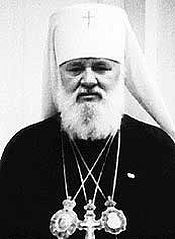 "Metropolitan” John Bodnarchuk. Photo: avemaria.ru Vladimir Romaniuk was not the only high-ranking hierarch of a schism whose days came to a mysterious end. There’s a whole host of them. I will note the most famous cases. First of all, of course, is “Metropolitan” John (Bodnarchuk), the founder of the schismatic “episcopate” and “First Hierarch of the UAOC.” This bishop of the Russian Orthodox Church endured arrests and exiles and was the bishop of Zhytomyr; however, according to his own confession, [it happened because] he did not get along with Philaret’s all-powerful wife Evgenia Petrovna Rodionova,13 conflicted with the leadership, and was forbidden to serve, and went to the autocephalous schism, where he became the “First Hierarch,” and later left there too. Having repented, he filed a petition to return to the canonical Church, where they postponed the examination of the question until the Local Council of the Russian Orthodox Church. As it turned out for Bodnarchuk, it was too long a wait, and in 1993 the schismatics managed to lure him to the UOC-KP: They needed people with a dissident’s biography. Although in the schism he turned out to be not so much a supporter of Philaret as much as an assistant to Romaniuk. On November 8, 1994, on the way to Lutsk, near the village of Mirnoe in the Gorokhovsky Region of the Volyn Province, Bodnarchuk died in a car accident. The peasants working in the gardens who witnessed the accident related that a loaded truck stood on the side of the road for four hours with the engine running. When Bodnarchuk’s car got close, the truck sharply turned onto the roadway, causing the fatal crash. The famous political actor Vyacheslav Chernovol later died under similar circumstances.
"Metropolitan” John Bodnarchuk. Photo: avemaria.ru Vladimir Romaniuk was not the only high-ranking hierarch of a schism whose days came to a mysterious end. There’s a whole host of them. I will note the most famous cases. First of all, of course, is “Metropolitan” John (Bodnarchuk), the founder of the schismatic “episcopate” and “First Hierarch of the UAOC.” This bishop of the Russian Orthodox Church endured arrests and exiles and was the bishop of Zhytomyr; however, according to his own confession, [it happened because] he did not get along with Philaret’s all-powerful wife Evgenia Petrovna Rodionova,13 conflicted with the leadership, and was forbidden to serve, and went to the autocephalous schism, where he became the “First Hierarch,” and later left there too. Having repented, he filed a petition to return to the canonical Church, where they postponed the examination of the question until the Local Council of the Russian Orthodox Church. As it turned out for Bodnarchuk, it was too long a wait, and in 1993 the schismatics managed to lure him to the UOC-KP: They needed people with a dissident’s biography. Although in the schism he turned out to be not so much a supporter of Philaret as much as an assistant to Romaniuk. On November 8, 1994, on the way to Lutsk, near the village of Mirnoe in the Gorokhovsky Region of the Volyn Province, Bodnarchuk died in a car accident. The peasants working in the gardens who witnessed the accident related that a loaded truck stood on the side of the road for four hours with the engine running. When Bodnarchuk’s car got close, the truck sharply turned onto the roadway, causing the fatal crash. The famous political actor Vyacheslav Chernovol later died under similar circumstances.
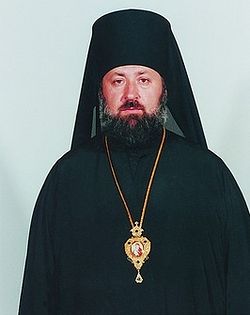 “Metropolitan” Anthony Masendycz. Photo: wikimedia.org “Metropolitan” Anthony Masendycz. Co-founder of the UOC-KP. Without the knowledge of the “patriarch” of the UAOC Mistislav, in 1992 he joined the defrocked Philaret and the treasury of the UOC stolen by him, and organized the schismatic UOC-KP. But just two year later, with other autocephalous bishops, he came forward with an address to the Ukrainian people about how “Philaret is leading people to eternal destruction.” Having survived (according to him) two attempts on his life, he fled to Russia, having seized some compromising material (he obtained it together with Romaniuk) on Philaret (about his work with the KGB). He offered his repentance to the Russian Orthodox Church and was sent to serve in Altai. He took the compromising material with him. Everyone was waiting for a book from him exposing the Philaretians. However, Masendycz suddenly died in 2001 in his forty-first year of life.
“Metropolitan” Anthony Masendycz. Photo: wikimedia.org “Metropolitan” Anthony Masendycz. Co-founder of the UOC-KP. Without the knowledge of the “patriarch” of the UAOC Mistislav, in 1992 he joined the defrocked Philaret and the treasury of the UOC stolen by him, and organized the schismatic UOC-KP. But just two year later, with other autocephalous bishops, he came forward with an address to the Ukrainian people about how “Philaret is leading people to eternal destruction.” Having survived (according to him) two attempts on his life, he fled to Russia, having seized some compromising material (he obtained it together with Romaniuk) on Philaret (about his work with the KGB). He offered his repentance to the Russian Orthodox Church and was sent to serve in Altai. He took the compromising material with him. Everyone was waiting for a book from him exposing the Philaretians. However, Masendycz suddenly died in 2001 in his forty-first year of life.
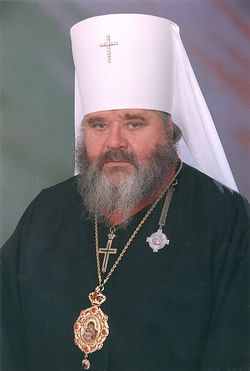 “Metropolitan” Jacob Panchuk. Photo: www.pravoslaviavolyni.org.ua “Metropolitan” Jacob Panchuk. The sole Ukrainian Orthodox hierarch who, being a vicar bishop, supported the expelled-from-the-UOC Philaret. In his group, he became a “metropolitan.” In 2004, he went to the Pochaev Lavra to say goodbye to his dying spiritual father, to whom he had promised to return to the canonical Church. He was constantly tormented by being in schism. A few months after his trip, he became ill in Philaret’s residence on Pushkin Street, from where the ambulance took him to the Theophania Hospital. He died in the emergency room. Those who have fled from Philaret are certain that Panchuk, like Romaniuk, was poisoned.
“Metropolitan” Jacob Panchuk. Photo: www.pravoslaviavolyni.org.ua “Metropolitan” Jacob Panchuk. The sole Ukrainian Orthodox hierarch who, being a vicar bishop, supported the expelled-from-the-UOC Philaret. In his group, he became a “metropolitan.” In 2004, he went to the Pochaev Lavra to say goodbye to his dying spiritual father, to whom he had promised to return to the canonical Church. He was constantly tormented by being in schism. A few months after his trip, he became ill in Philaret’s residence on Pushkin Street, from where the ambulance took him to the Theophania Hospital. He died in the emergency room. Those who have fled from Philaret are certain that Panchuk, like Romaniuk, was poisoned.
“Metropolitan” Andrei Gorak of Lvov. Archbishop of the UOC. In 1992, he was blocked by nationalists in Lvov and forced to transfer to Philaret’s schism. He was deprived of every degree of the priesthood by the Orthodox Church. Many times he tried to return with repentance to the bosom of the canonical Church. Once he was caught while already in Kiev on the way to the Lavra and was taken to Lvov.
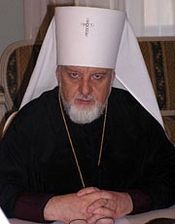 “Metropolitan” Andrei Gorak. Photo: www.anti-raskol.ru On July 27-28, 2010, during a visit to Kiev on the feast of St. Vladimir with His Holiness Patriarch Kirill and the primates of the Local Churches, “Metropolitan” Andrei Gorak of the UOC-KP and “Archbishop” Theodosy Petsina of Drogobych of the UAOC were supposed to be an example and edification to those gathered in their schisms to return to the bosom of the canonical Orthodox Church—the UOC. They had made an agreement about it with the hierarchs of the UOC and ROC. However, in July, both suddenly came down with an acute illness. “Metropolitan” Andrei Gorak died on July 5 in his sixty-fifth year of life, and “Archbishop” Theodosy of Drogobych suddenly died on July 23 in his own car, in his fifty-first year of life. One missed officially returning to the Church of Christ by one week, the other by three.
“Metropolitan” Andrei Gorak. Photo: www.anti-raskol.ru On July 27-28, 2010, during a visit to Kiev on the feast of St. Vladimir with His Holiness Patriarch Kirill and the primates of the Local Churches, “Metropolitan” Andrei Gorak of the UOC-KP and “Archbishop” Theodosy Petsina of Drogobych of the UAOC were supposed to be an example and edification to those gathered in their schisms to return to the bosom of the canonical Orthodox Church—the UOC. They had made an agreement about it with the hierarchs of the UOC and ROC. However, in July, both suddenly came down with an acute illness. “Metropolitan” Andrei Gorak died on July 5 in his sixty-fifth year of life, and “Archbishop” Theodosy of Drogobych suddenly died on July 23 in his own car, in his fifty-first year of life. One missed officially returning to the Church of Christ by one week, the other by three.
“Archbishop” Theodosy Petsina of Drogobych. Priest of the UOC. He moved to Philaret’s schism in 1992, where he became an “archbishop.” Then he went to the UAOC, where he became the “Archbishop” of Drogobych and Sokal. He constantly sought a way to return to the canonical Church.
These are only the most famous names, but they testify that the path of returning from schism to the Church of Christ the Savior is dangerous and difficult, and in any case requires courage.

